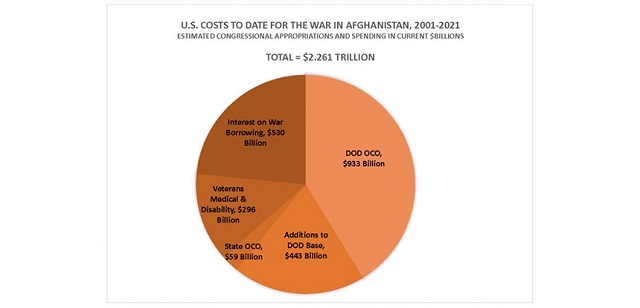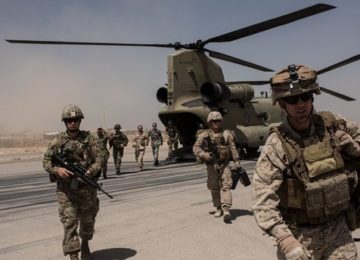April 20, 2021
With Biden’s announcement of completing the troops’ withdrawal process by September 11, 2021, the Costs of War Project by the Watson Institute for International and Public Affairs published a report with the comprehensive and up-to-date account of the estimated costs of the U.S. war in Afghanistan, both economically and in terms of casualties.
According to the report, the United States has spent $2.26 trillion on the war on terror during operations in both Afghanistan and Pakistan, since 2001 when the US invaded Afghanistan. This figure includes the finances US spent on the Defense Department Overseas Contingency Operations (OCO) (War) Budget, State Department OCO (War) Budget, Defense Department Base Budget War-Related Increases, Veterans Care for Afghan War Vets, and Estimated Interest on War Borrowing. However, this $2.26 doesn’t include the funds that the United States government is obligated to spend on lifetime care for American veterans of this war, nor does it include future interest payments on money borrowed to fund the war.
The report also estimated that 241,000 people have lost their lives as a direct result of this war. This includes at least 71,344 civilians; 2,442 American service members; 78,314 Afghan military and police; and 84,191 opposition fighters. These figures do not include deaths caused by disease, loss of access to food, water, infrastructure, and/or other indirect consequences of the war including psychological and social problems.
The Costs of War Project has published the report in the light of the data it has recorded for the past 10 years by compiling regularly updated estimates of the budgetary and human costs of the U.S. post-9/11 wars. The figures for Afghanistan are part of the larger costs of these wars, which extend to Iraq, Syria, Yemen, Somalia and elsewhere. The numbers are approximations based on the reporting of several data sources.
According to Dr. Neta Crawford, lead researcher, co-director of Costs of War and professor at Boston University, “The DOD spending, at over $900 billion in Afghanistan, is the tip of the iceberg. The costs of the Afghanistan war include its escalation into Pakistan, millions of refugees and displaced persons, the toll in lives of combatants and non-combatants, and the need to care for America’s veterans. The Pentagon’s base budget has increased as well. We report these estimates so that the American people will have a better understanding of the scale of the effort and its consequences. The American people also lost some transparency here. A more comprehensive accounting is yet to be completed. It would include not just money that may or may not have been well spent, but the count of those wounded, those who lost limbs, and the tremendous psychological toll of decades of war on combatants and noncombatants and their families.”
Dr. Catherine Lutz, co-director of Costs of War and professor at Brown University, says, “These horrific numbers are testament to the costs of war, first to the Afghan people, and then to the soldiers and people of the United States. Ending the war as soon as possible is the only rational and humane thing to do.”
© Center for Research and Security Studies (CRSS) and Afghan Studies Center (ASC), Islamabad.








